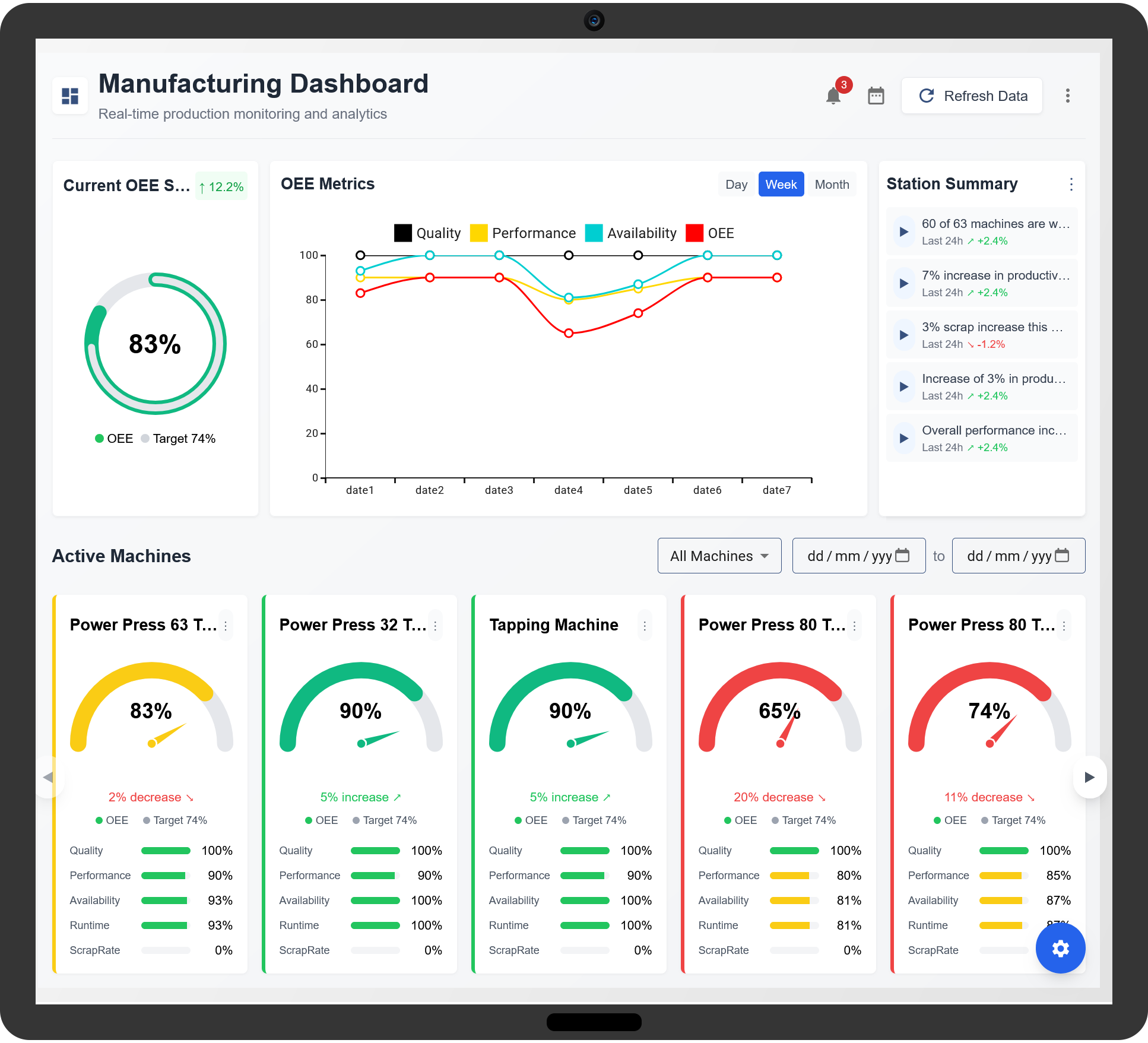OEE (Overall Equipment Effectiveness) data collection software is essential for tracking manufacturing performance, reducing downtime, and improving productivity. By automating data capture from machines, sensors, and operators, this software provides real-time insights into availability, performance, and quality metrics. With advanced analytics and reporting, manufacturers can identify inefficiencies and implement corrective actions for continuous improvement.

1. Importance of OEE Data Collection
Accurate data collection is the foundation of effective OEE measurement. Without reliable and real-time data, manufacturers cannot make informed decisions to optimize operations.
- Enhanced Accuracy: Eliminates manual data entry errors.
- Real-Time Insights: Provides instant visibility into production performance.
- Data-Driven Decision Making: Supports continuous improvement strategies.
2. Key Features of OEE Data Collection Software
Advanced OEE data collection software includes several features to streamline performance tracking and analysis:
- Automated Machine Data Capture: Collects real-time data from sensors and production equipment.
- Operator Input Interface: Allows manual data entry for reasons such as downtime and defects.
- Live Dashboards: Displays availability, performance, and quality metrics in an intuitive format.
- Customizable Reports: Generates insights based on historical and real-time data.
- Integration with Other Systems: Connects with ERP, MES, and CMMS for a unified workflow.
3. Automated vs. Manual Data Collection
OEE data can be collected either manually or automatically, depending on the factory’s infrastructure. Each method has its advantages and challenges.
Automated Data Collection
- Uses sensors, PLCs, and IoT devices for real-time monitoring.
- Reduces human error and improves data accuracy.
- Provides instant updates for better decision-making.
Manual Data Collection
- Requires operator input for downtime and quality issues.
- Can be useful for tracking non-measurable events.
- Prone to delays and inaccuracies.
4. How to Set Up an OEE Data Collection System
Setting up an OEE data collection system involves integrating the right technology, defining data collection parameters, and ensuring usability for operators.
Step 1: Define Key Metrics
Identify the core OEE components that need to be measured—availability, performance, and quality. Ensure that each metric is aligned with production goals.
Step 2: Choose Data Collection Methods
Decide between automated or manual data collection, depending on machine capabilities and budget.
Step 3: Integrate with Production Equipment
Connect sensors, PLCs, and IoT devices to capture real-time machine performance data.
Step 4: Configure Data Dashboards
Set up dashboards to display live OEE metrics, trend analysis, and alerts for deviations.
Step 5: Train Operators and Staff
Ensure employees understand how to input manual data and interpret system outputs.
Step 6: Monitor and Improve
Regularly analyze collected data to identify inefficiencies and implement corrective actions.
5. Benefits of Real-Time OEE Data Collection
Implementing real-time OEE data collection software provides several advantages:
- Reduced Downtime: Immediate identification of machine stoppages.
- Higher Productivity: Optimizes production speed and reduces cycle time losses.
- Improved Quality: Helps identify defects early, reducing waste.
- Data Accuracy: Eliminates manual entry errors.
- Faster Decision Making: Provides real-time insights for proactive management.
6. Challenges in OEE Data Collection
While OEE data collection software improves efficiency, manufacturers may face challenges during implementation.
- Data Overload: Managing large volumes of machine data requires effective filtering.
- System Integration: Ensuring compatibility with existing manufacturing systems.
- Operator Adoption: Encouraging staff to engage with the system.
- Connectivity Issues: Ensuring stable network connections for cloud-based OEE solutions.
7. Advanced Analytics and Predictive Insights
Modern OEE software incorporates advanced analytics to enhance production efficiency further.
- Predictive Maintenance: Uses AI-driven insights to forecast equipment failures.
- Root Cause Analysis: Identifies factors contributing to low OEE scores.
- Trend Analysis: Detects long-term performance patterns.
OEE Data Collection Software
What is OEE data collection software?
OEE data collection software is a tool that gathers, analyzes, and reports Overall Equipment Effectiveness (OEE) data to help manufacturers optimize production efficiency.
How does OEE data collection software improve manufacturing efficiency?
By capturing real-time data on availability, performance, and quality, OEE software helps identify inefficiencies and streamline production processes.
What types of data does OEE software collect?
OEE software collects data on machine availability, production speed, downtime, defects, and other key performance indicators.
How does real-time data collection enhance OEE tracking?
Real-time data collection provides instant insights into production performance, allowing for quicker decision-making and problem resolution.
What are the key benefits of automated OEE data collection?
Automated OEE data collection eliminates manual errors, reduces reporting time, enhances accuracy, and provides actionable insights for process improvement.
How does OEE data collection software help reduce downtime?
By monitoring machine performance and identifying patterns, OEE software helps predict and prevent unplanned downtime.
What methods are used for collecting OEE data?
OEE data can be collected through manual entry, automated sensors, IoT devices, and direct machine connectivity.
How does OEE software ensure data accuracy?
OEE software ensures accuracy by automating data collection, reducing human errors, and cross-verifying data points with historical trends.
Can OEE data collection software integrate with existing systems?
Yes, OEE data collection software integrates with ERP, MES, SCADA, and other manufacturing systems to provide a unified view of production data.
What role does machine connectivity play in OEE data collection?
Machine connectivity enables direct data capture from equipment, ensuring real-time and accurate monitoring of OEE metrics.
How does OEE software support root cause analysis?
OEE software identifies patterns in production losses, helping manufacturers pinpoint the root causes of inefficiencies.
What are the different ways to visualize OEE data?
OEE data can be visualized through dashboards, charts, heatmaps, and trend reports for better decision-making.
How does OEE data collection help in predictive maintenance?
By analyzing machine performance trends, OEE software predicts potential failures, allowing for proactive maintenance.
What are the challenges of manual OEE data collection?
Manual OEE data collection is prone to errors, time-consuming, and lacks real-time insights, making it less effective for continuous improvement.
How does OEE data collection software contribute to continuous improvement?
OEE software provides data-driven insights that help manufacturers implement strategies for ongoing process optimization and efficiency gains.